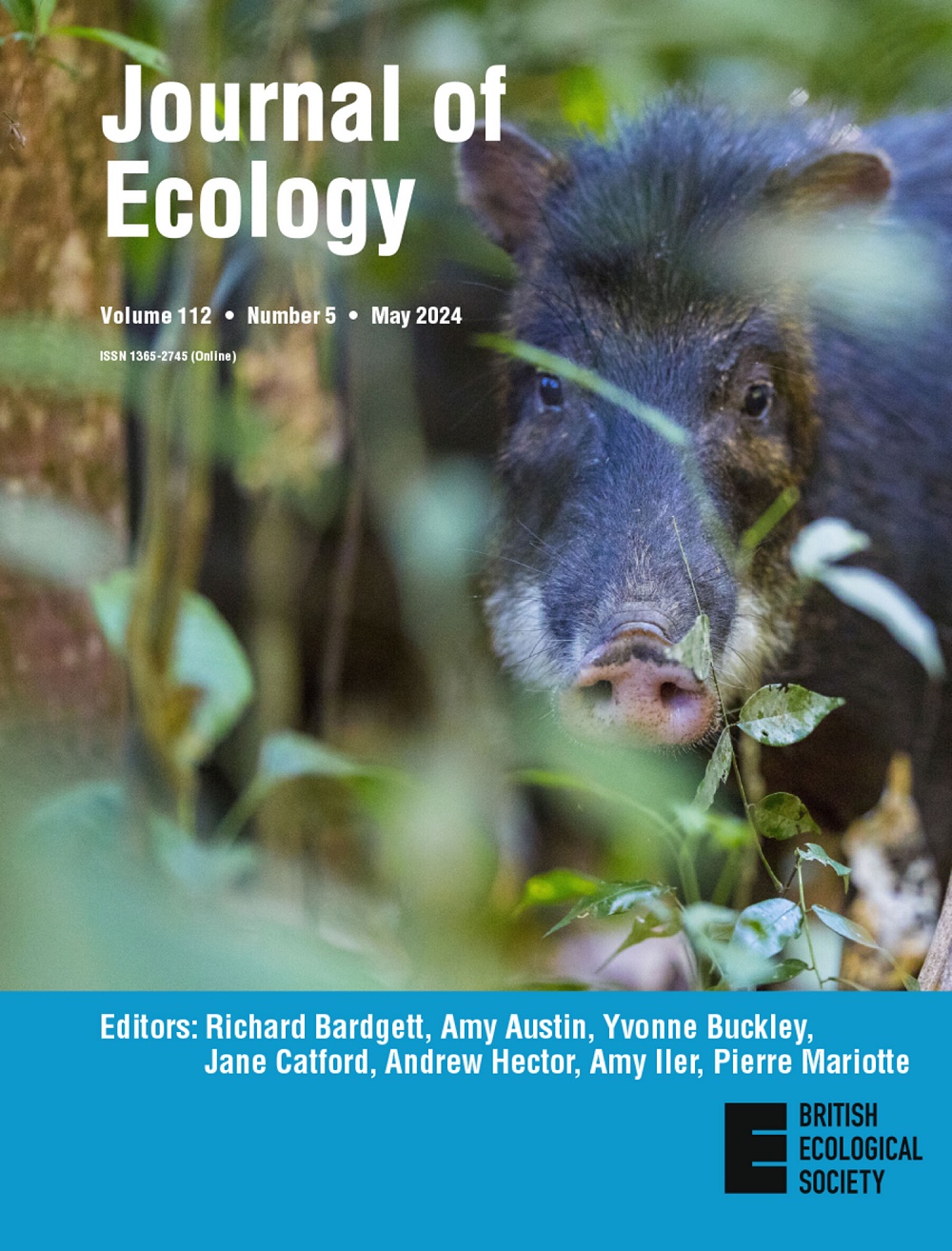Responses of naturalized alien plants to soil heterogeneity and competition vary with the global naturalization success of the native competitors
IF 5.3
1区 环境科学与生态学
Q1 ECOLOGY
引用次数: 0
Abstract

外来植物归化后对土壤异质性和竞争的反应随着本土竞争者的归化成功而变化
随着人类、文化和商品流动的增加,越来越多的物种跨越地理障碍进入新的地区,导致植物区系同质化(Kinlock et al., 2022;Yang等人,2021)。在这些所谓的外来物种中,有一部分已经在自然界中形成了自我维持的种群(即归化外来物种),而那些传播迅速且经常对环境产生负面影响的归化物种被认为是入侵物种(Blackburn et al., 2011;Richardson et al., 2000)。然而,归化是入侵过程的中心阶段,研究和理解归化外来物种入侵(即建立)到当地社区的机制具有重要意义(Richardson &;Pyš埃克,2012)。在过去的几个世纪里,全球至少有13000种植物由于人类活动而归化,在可预见的未来,生物入侵的步伐似乎不会放缓(Seebens et al., 2017;Seebens et al., 2021;van Kleunen et al., 2015)。因此,外来植物如何与本地植物相互作用仍然是生态学的关键问题之一。为了减少生物入侵,保持本地生物多样性和生态系统在全球变化下的功能,回答这个问题是必要的(IPBES, 2023;valadares et al., 2015)。外来植物和本地植物之间的竞争通常被认为在入侵过程中起重要作用(Gioria &;奥斯本2014;Kuebbing,涅斯,2015)。大量的研究已经测试了外国人是否在不同方面比本地人更有竞争力,但尚未达成一致(Kuebbing &;涅斯,2016;维拉港和维纳,2004;张,van Kleunen, 2019)。所以,关键问题是什么决定了外来物种的竞争力,它们真的与本地物种不同吗?对于后者,重要的是要考虑到一个地区的原生物种可能同时是其他地区的归化外来物种(van Kleunen et al., 2010)。因此,在比较外来物种和本地物种时,考虑本地物种在世界其他地区作为归化外来物种的成功程度可能很重要。同样,并非所有归化的外来物种都具有同样的竞争力和成功。有些出现在相对较少的地区或在其非原生范围内相对罕见。因此,在一个地区的本地物种和外来物种中,我们在区域和全球范围内都有成功的和不太成功的物种。通常,在全球广泛分布的物种比分布较少的物种生长得更快(Dawson et al., 2011)。最近的一项研究还发现,普通外来物种比稀有本地物种更具竞争力,但不一定比普通本地物种更具竞争力,因为两组普通物种的内在增长率都很高(Zhang &;van Kleunen, 2019)。此外,研究表明,普通物种,尤其是普通外来物种,可能会更多地利用营养添加(即富营养化),从而提高竞争力(Dawson et al., 2012)。然而,这是否是一种普遍模式,以及它如何取决于资源的空间分布,目前尚不清楚。土壤非均质性,即养分、土壤类型和土壤各种理化特征的不均匀分布(Xue et al., 2019)在自然界中普遍存在。异质性土壤会影响种子萌发(Liu &;侯,2021),无性系植物分株放置(Dong et al., 2015),根系觅食(Keser et al., 2014),以及植物的生长和生物量分配(Liu, Li等,2021)。此外,异质土壤被认为可以创造更多的生态位机会,从而可以促进物种共存(Beck &;Givnish, 2021;Liu, Bortier等,2021;干草,亨利,2019)。事实上,最近的一些研究发现,土壤异质性通过减轻来自本地植物群落的竞争压力,使常见的外来物种受益(Gao等,2021;魏,van Kleunen, 2022)。然而,对于不太常见的外来物种是否也是如此,以及它如何取决于本地竞争对手本身是否作为外来物种在其他地方广泛存在,仍然未知。在这里,我们对德国的7种稀有外来物种和7种常见外来物种进行了实验。我们将这14种外来物种单独或与15种本地物种进行配对竞争,其中10种被广泛归化到其他地方(德国以外),5种未被广泛归化。 通过210对异质和均质土壤上的外来-本地竞争对,我们旨在回答以下问题:(1)外来物种是否比本地物种更能利用异质土壤条件,并且这种效应是否在常见外来物种中比在稀有物种中更强?(2)外来物种,特别是稀有物种,在与世界其他地方广泛归化的本地物种竞争时,竞争力是否会下降?
本文章由计算机程序翻译,如有差异,请以英文原文为准。
求助全文
约1分钟内获得全文
求助全文
来源期刊

Journal of Ecology
环境科学-生态学
CiteScore
10.90
自引率
5.50%
发文量
207
审稿时长
3.0 months
期刊介绍:
Journal of Ecology publishes original research papers on all aspects of the ecology of plants (including algae), in both aquatic and terrestrial ecosystems. We do not publish papers concerned solely with cultivated plants and agricultural ecosystems. Studies of plant communities, populations or individual species are accepted, as well as studies of the interactions between plants and animals, fungi or bacteria, providing they focus on the ecology of the plants.
We aim to bring important work using any ecological approach (including molecular techniques) to a wide international audience and therefore only publish papers with strong and ecological messages that advance our understanding of ecological principles.
 求助内容:
求助内容: 应助结果提醒方式:
应助结果提醒方式:


